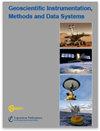Copper permalloys for fluxgate magnetometer sensors
IF 2.3
4区 地球科学
Q3 GEOSCIENCES, MULTIDISCIPLINARY
Geoscientific Instrumentation Methods and Data Systems
Pub Date : 2024-06-05
DOI:10.5194/gi-13-131-2024
引用次数: 0
Abstract
Abstract. Fluxgate magnetometers are commonly used to provide high-fidelity vector magnetic field measurements. The magnetic noise of the measurement is typically dominated by that intrinsic to a ferromagnetic core used to modulate (gate) the local field as part of the fluxgate sensing mechanism. A polycrystalline molybdenum–nickel–iron alloy (6.0–81.3 Mo permalloy) has been used in fluxgates since the 1970s for its low magnetic noise. Guided by previous investigations of high-permeability copper–nickel–iron alloys, we investigate alternative materials for fluxgate sensing by examining the magnetic properties and fluxgate performance of that permalloy regime in the range 28 %–45 % Cu by weight. Optimizing the alloy constituents within this regime enables us to create fluxgate cores with both lower noise and lower power consumption than equivalent cores based on the traditional molybdenum alloy. Racetrack geometry cores using six layers of ∼30 mm long foil washers consistently yield magnetic noise around 4–5 pT/Hz at 1 Hz and 6–7 pT/Hz at 0.1 Hz, meeting the 2012 1 s INTERMAGNET standard of less than 10 pT/Hz noise at 0.1 Hz.用于磁通门磁力计传感器的铜过合金
摘要。磁通门磁力计通常用于提供高保真矢量磁场测量。作为磁通门传感机制的一部分,测量的磁噪声通常由用于调制(栅极)局部磁场的铁磁磁芯的固有噪声所主导。自 20 世纪 70 年代以来,一种多晶钼镍铁合金(6.0-81.3 Mo permalloy)因其低磁噪声而被用于磁通门中。在之前对高磁导率铜镍铁合金研究的指导下,我们研究了用于磁通门传感的替代材料,检查了该过合金在 28%-45% 铜(重量百分比)范围内的磁特性和磁通门性能。在此范围内优化合金成分,使我们能够制造出比基于传统钼合金的同等磁芯噪音更低、功耗更低的磁通门磁芯。采用六层 30 毫米长箔垫圈的 Racetrack 几何磁芯在 1 赫兹和 0.1 赫兹时的磁噪声分别为 4-5 pT/Hz和 6-7 pT/Hz,符合 2012 年 1 s INTERMAGNET 标准,即 0.1 赫兹时的噪声小于 10 pT/Hz。
本文章由计算机程序翻译,如有差异,请以英文原文为准。
求助全文
约1分钟内获得全文
求助全文
来源期刊

Geoscientific Instrumentation Methods and Data Systems
GEOSCIENCES, MULTIDISCIPLINARYMETEOROLOGY-METEOROLOGY & ATMOSPHERIC SCIENCES
CiteScore
3.70
自引率
0.00%
发文量
23
审稿时长
37 weeks
期刊介绍:
Geoscientific Instrumentation, Methods and Data Systems (GI) is an open-access interdisciplinary electronic journal for swift publication of original articles and short communications in the area of geoscientific instruments. It covers three main areas: (i) atmospheric and geospace sciences, (ii) earth science, and (iii) ocean science. A unique feature of the journal is the emphasis on synergy between science and technology that facilitates advances in GI. These advances include but are not limited to the following:
concepts, design, and description of instrumentation and data systems;
retrieval techniques of scientific products from measurements;
calibration and data quality assessment;
uncertainty in measurements;
newly developed and planned research platforms and community instrumentation capabilities;
major national and international field campaigns and observational research programs;
new observational strategies to address societal needs in areas such as monitoring climate change and preventing natural disasters;
networking of instruments for enhancing high temporal and spatial resolution of observations.
GI has an innovative two-stage publication process involving the scientific discussion forum Geoscientific Instrumentation, Methods and Data Systems Discussions (GID), which has been designed to do the following:
foster scientific discussion;
maximize the effectiveness and transparency of scientific quality assurance;
enable rapid publication;
make scientific publications freely accessible.
 求助内容:
求助内容: 应助结果提醒方式:
应助结果提醒方式:


